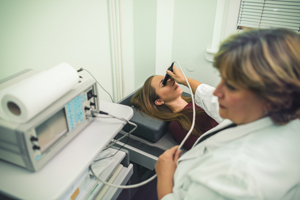
What is Ocular Ultrasound?
Ocular ultrasound, also known as ocular ultrasonography, “echo,” or a B-scan, is a non-invasive, safe diagnostic test employed to evaluate structural integrity and pathologies of the eye.
Ocular ultrasound is a crucial additive for the clinical assessment of several orbital and ocular diseases and provides a two-dimensional cross-sectional image of the internal structures of the eye and the orbit, not possible by clinical examination alone. It is specifically helpful in patients with pathology that hinders or obscures ophthalmoscopy. It enables your ophthalmologist to accurately visualize eye structures like the sclera, choroid, lens, retina, and vitreous and help to determine various eye deformities.
Indications for Ocular Ultrasound
Ocular ultrasound is commonly indicated to evaluate conditions, such as:
- Vitreous degeneration
- Retinal or choroidal detachment
- Ocular trauma
- Retinoblastoma
- Choroidal melanoma
- Cataract
- Vitreous hemorrhage
- Eye tumors
Preparation for Ocular Ultrasound
Ocular ultrasound does not require any specific preparation.
Procedure for Ocular Ultrasound
Ocular ultrasound is a painless procedure and takes about 10 to 15 minutes to complete. The test is mostly performed in your ophthalmologist’s office or in a hospital or clinic setting and involves the following steps:
- You will be placed in a seated position.
- Anesthetic drops are used to numb your eyes.
- An ultrasound gel is applied on the skin of your eyelids.
- Your ophthalmologist will ask you to keep your eyes closed and move your eyeballs in several directions.
- A hand-held transducer (ultrasound wand) is placed on the eye surface.
- The high-frequency sound waves of the ultrasound travel through the eye to create detailed images of the eye structure.
- The images are then transmitted to a monitor connected to the ultrasound machine for review by your ophthalmologist.
Post-Procedure Care and Instructions
Ocular ultrasound is performed fairly quickly, and you may leave your ophthalmologist’s office in around 30 minutes’ time. You should refrain from rubbing your eyes until the anesthetic has completely worn off. You should be able to drive 30 minutes after the procedure; although, it is advisable if a friend or family member drives you home. A follow-up appointment will be scheduled by your physician to discuss the findings of the test and to recommend appropriate treatment.
Related Topics
- General Eye Examination & Care
- Digital Retinal Photography
- Optical Coherence Tomography (OCT)
- Ocular Ultrasound
- Visual Field Testing
- Anti-VEGF Treatments
- Vitreoretinal Surgery
- Retinal Laser Therapy
- Pattern Laser Technology
- Cataract Surgery in People with Retinal Diseases
- Cataract Surgery in Diabetics
- Intraocular Lens (IOL)
- Premium Intraocular Lens (IOL)
- Photorefractive Keratectomy (PRK)
- Pediatric Ophthalmology
- Ultrasound Biomicroscopy
- Heidelberg Retinal Tomography

